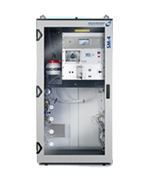|
##Continuous operation
##Sample dilution: system works with virtually any sample matrix
##Maintenance free converter directly at stack: no transport of reactive mercury over distance thus minimizing mercury adsorption
##Thermo-catalytic converter principle operating at low temperature
##Detects elemental, ionic and bound mercury
##Mercury speciation available (as an option)
##Automatic calibration systems (oxidized and elemental) available
##Automatic QAL3 as an option
##Approved and certified by TÜV Rheinland Energie und Umwelt GmbH, Köln Report-Nr.: 936/21213740/A of March 26, 2012
Applications
Mercury Instruments has specially designed the SM-4 Mercury Stack Monitor to meet requirements to measure very low Hg concentrations in stack gases with a matrix containing SO2, NOx, HCl and others. Applications for the SM-4 include coal-fired plants, waste incinerators, cement kilns and all other operations with process gases that contain mercury traces in a complex matrix.

Operating Principle
The heated sampling probe is mounted at the stack. A maintenance-free ejector pump continuously draws sample gas into a dilution unit and past a heated particle filter. A critical orifice stabilizes the sample flow, thus making it independent of the pressure in the stack. The suction vacuum is continuously monitored by a pressure sensor to make operation reliable. A partial flow of the diluted sample is passed through a catalyst where the different forms of mercury contained in the sample are converted to the elemental state. This treated sample is then transported to the mercury detector through slightly heated PFA tubing , which may be tens or even some hundreds of feet away from the sampling probe. The detector uses a pre-concentration technique featuring the unique Mercury Instruments GoldTrap, one of the most sensitive and selective mercury detection devices in the market.

Thermocatalytic Reactor
The mercury present in stack gases is often elemental, but ionic and bound mercury occurs also. To measure total mercury, all these different species must be successfully detected. To this end the SM-4 uses a thermocatalytic method to convert all mercury to its elemental form. The reactor works without wet chemistry at low temperature (200 °C) and therefore assures high reliability with low demand for maintenance.
Detector The SM-4 uses a highly sensitive detector based on the atomic absorption principle, and featuring an amalgamation unit (GoldTrap) connected upstream. The ultrapure gold surface captures the mercury which is then abruptly released when the gold trap is rapidly heated to approximately 700° C. Purified air is used as a carrier and there is no need for special carrier gases.
Sampling Probe
The sampling probe has a key role: to extract a representative sample of gas and supply it to the sample conditioning system. All parts that come into contact with the sample are made of special material, guaranteeing a minimum memory effect. All parts are heated so no mercury is retained in the probe. An automatically backflushed filter keeps particles away from the analytical pathway of the sample. Calibration gas is introduced upstream of the sample filter. Both the dilution unit and the catalyst are integral to the sampling probe, thus ensuring minimum length for their connecting lines.

Prevention of Interferences
SO2, NOx, HCl, and VOCs all interfere with standard mercury measurement techniques. The most up-to-date mercury CEMs try to minimize this negative effect with an amalgamation step or sample dilution. Amalgamation alone, however, reaches its limit when the gold surface is affected by matrix constituents, whereas sample dilution alone may not reduce interference to tolerable levels. The SM-4 uses both sample dilution and gold trap amalgamation to completely eliminate interference.
Automatic Calibration
The SM-4 is packaged with daily calibration sources as per EPA and other national and international quality control requirements. It is available with built-in span calibration sources for elemental or ionic mercury and can also perform a baseline check automatically. The latest development is a calibration gas generator that produces ionic mercury reference gas and can be integrated into the SM-4 system for automatic operation. Quality assurance during operation as required by the European Regulation EN 14181 (QUAL3) can be performed automatically.
Features and Benefits of the SM-4
##Dry thermocatalytic method: no need for reagents, water refills or solid reagent cartridge replacements.
##Sample dilution eliminates interference from matrix gases such as SO2, NOx, and HCl and produces a large measuring range.
##Approved according to European regulations, for USA: RATA tests passed with excellent result
##No liquid waste or condensate is generated
##Extreme high sensitivity: low measuring range is 0.05 µg/m³
##Automatic cleaning of particulate filter
##Fast response: t(90) time typically 180 sec
##Sample line length up to 300 feet
##ionic calibration gas generator as an option allows automatic quality assurance (QAL3)
##Option to install an elemental mercury calibration gas generator, NIST traceable, inside the analyzer cabinet
##Very low maintenance System components
##Sample conditioning system with detachable sampling probe
##Heated bundle containing sample line, air supply line, calibration gas feed line
##Probe controller module
##Analyzer cabinet with detector and calibrator (option) |










